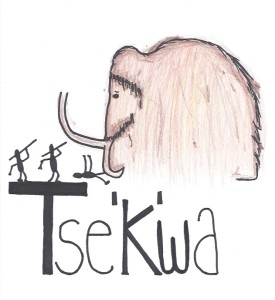About Tse’K’wa
Tse’K’wa, or the Charlie Lake Cave archaeological site and property, is one of the few known archaeological sites in northern British Columbia that date before 11,000 years ago, and one of the even fewer with a well preserved stratigraphic record of human activities. At one time, below the site, was the enormous Glacial Lake Peace, which stretched from the BC and Alberta Border to the foothills of the Rockies. Between 10,500 to 10,200 years ago the lake drained rapidly because of the glaciers melting. Nearly 10,500 years before present, a large joint fractured boulder (the parapet) fell way from the sandstone bedrock (rock base), moving three meters down slope without toppling over. This event exposed the cave and created a twelve-meter long gully in front of the cave. It also created a trap for soil being washed down the hill and the gully has been filled with layers of soil and in turn artifacts for the last 10,500 years.
The site was well known by local First Nations, but it was first documented in 1974 by an archaeologist named Knut Fladmark, who was conducting a field investigation for the Bennett Dam. Fladmark returned with Dr. Jon Driver from Simon Fraser University to excavate it in 1983, then in 1990 and 1991. All together there were 23, one by one meter, excavation units placed in the 4.5 meter wide and 6 meter deep gully at the mouth of cave. Over three field seasons, they unearthed 4 stratified levels and evidence of occupation spanning up to 11,000 years ago.
What was found?
- The lowest level and the oldest had several stone artifacts, a fluted point (a point with special groves on its side that was used to hunt large mammals such as bison and mammoth), 6 retouched flakes, spear points, arrow points, scraping tools and grinding tools, a harpoon head made of antler and bone, 2 cores, and a small soft stone bead.
- There was also a human mandible or jawbone found at the site and numerous animal remains such as bison, snowshoe hare, large hare, ground squirrel, grouse, lemming teeth, fish and remains from two raven bones.
What do these finds tell us?
- The pollen fossils (petrified remains) and animal bones showed that the environment was quite different than today. We know that the land, which was free of water and ice, supported open grassland and not the forest we see today.
- The excavations told us that early people were likely migrating (travelling) south to north, not north to south as presumed earlier, following the bison herd migrations and travel corridors.
- Although the site is situated in an ice-free corridor, this site was occupied at a period too late to be included in the peopling of the world theory (the idea that people populated the world by travelling down the ice free corridor).
- The fully intact raven bones suggest possible ceremonial use at the site.
- Even though there were artifacts and bison bones found in the gully, there wasn’t any found in the cave. And an analysis of the artifacts suggests that the cave and gully were not the primary place of occupation; rather it was the location above the site, and the cave may have been used for refuse, or for ceremony.
- Additional evidence showed that the fluted points discovered during the excavation are similar to the points found at the Indian Creek and Mill Iron sites in Montana – this tells of a shared technology and potential trade routes.
- Around 4,500 years ago, the site seems to have been used more intensively by humans. This may be because the gully below it filled up to a level, which made the cave easily accessible; or the creek below had very large stocks of fish, which were easy to catch during spawning season.
- Whatever the reason from 4,500 until the 18th century the site was used more frequently.
For more information and to request a site visit contact:
Alyssa Currie, Executive Director
Tse ‘K’ Wa Heritage Society
Email: tsekwaheritage@gmail.com
Phone: 250-224-7906
Please remember this is private property but we welcome visitors and ask that you arrange your visit by calling or emailing one of the ladies above. We are trying to discourage access to the caves from the bottom road (Rimrock) and would prefer folks to access the caves from the 12629 Butte Lane after confirming visit as per above.
We only ask that you treat this site as you would your own and take all garbage with you. We have been dealing with vandalism and graffiti at the site and want to raise the awareness of the significance of this site, not only to our people but to the people in the surrounding area. It is after all a part of the history of this place we call home.

